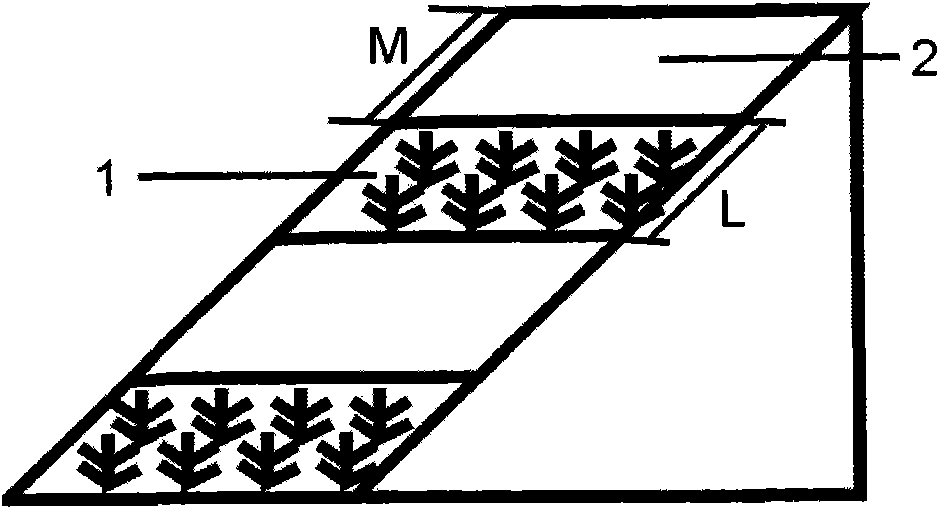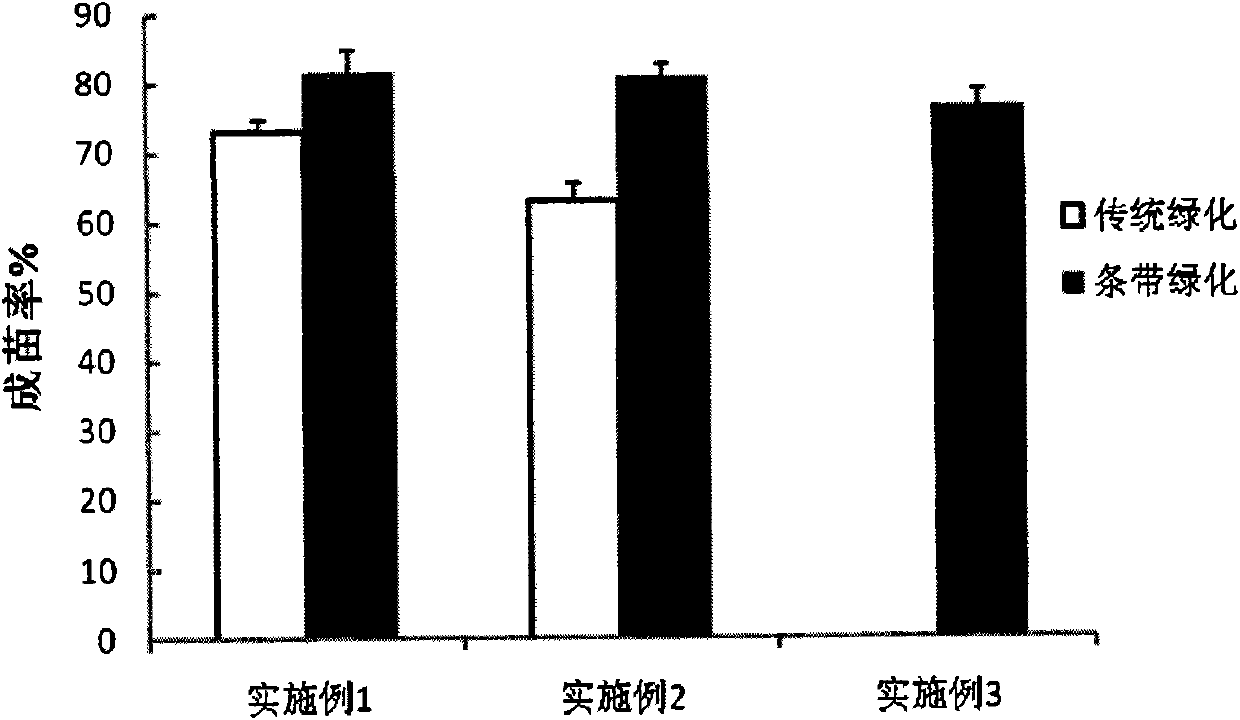Strip greening method of arid and semi-arid lands
A technology in semi-arid and regional areas, applied in the field of environmental greening in arid and semi-arid areas, can solve the problems of ignoring the ecological law of plant population level, treating the symptoms but not the root cause, and high cost, so as to achieve broad market space and application prospects, and improve the ecology Environmental and afforestation cost low effects
- Summary
- Abstract
- Description
- Claims
- Application Information
AI Technical Summary
Problems solved by technology
Method used
Image
Examples
Embodiment 1
[0015] see figure 1 , when greening slopes in arid and semi-arid areas, divide the green area into rain-collecting belt 2 and green belt 1, which are arranged alternately. Plant green grass and trees in the green belt 1, cover the plastic film in the rain-collecting belt 2, the ratio of the rain-collecting belt 2 and the green belt 1 can be obtained by the formula: Find, where x is the average annual rainfall, M is the width of the rain-collecting belt 2, and L is the width of the green belt 1.
[0016] From April to September 2008, the experiment was carried out in Xinyuan Township, Huining County, Gansu Province, where the average annual rainfall is 230mm. Choose a slope with a slope of about 8-15% as the test site, the width of the green belt 1 is set to 1m, and the width of the rain-collecting belt 2 can be obtained through the formula to be 1.2m, and the length of the green belt and the rain-collecting belt are both 5m. Set up two rain-collecting belts and two green be...
Embodiment 2
[0020] see figure 2 , when greening slopes in arid and semi-arid areas, divide the green area into rain-collecting belt 2 and green belt 1, plant green grass and trees in green belt 1, and cover plastic film in rain-collecting belt 2. The ratio of the rain-collecting belt 2 to the green belt 1 can be obtained by the formula: Find, where x is the average annual rainfall, M is the width of the rain-collecting belt 2, and L is the width of the green belt 1.
[0021] From April 1st to September 30th, 2009, the QYJY-501 portable fully automatic artificial simulated rainfall device was used to artificially simulate rainfall in the greenhouse of Zijingang Campus of Zhejiang University. The annual average rainfall was set at 350mm, which was brought into the formula: The theoretical value of the ratio of the width of the rain-collecting belt 2 to the width of the green belt 1 is 0.22. Put soil in a plastic turnover box with a size of 900×680×660mm and a volume of 400L, and set t...
Embodiment 3
[0025] The method of greening area planning is the same as in Example 1. From April 1, 2009 to September 30, in the greenhouse of Zijingang Campus of Zhejiang University, the QYJY-501 portable fully automatic artificial simulated rainfall device was used to artificially simulate rainfall. The rainfall is set at 260mm, which is brought into the formula: The theoretical value of the ratio of the width of the rain-collecting belt 2 to the width of the green belt 1 is 0.78. Put soil in a plastic turnover box with a size of 900×680×660mm and a volume of 400L, and set the slope at 25%, that is, the thickness of the highest part of the soil is 62.5cm, and the thickness of the lowest part is 40cm, simulating the area to be greened. When strip greening is carried out, the width of the green belt 1 is set as 20cm, and the width of the rain-collecting belt 2 can be obtained by the formula as 15.6cm. Two rain-collecting belts and two green belts are arranged in the turnover box above, a...
PUM
 Login to View More
Login to View More Abstract
Description
Claims
Application Information
 Login to View More
Login to View More - R&D
- Intellectual Property
- Life Sciences
- Materials
- Tech Scout
- Unparalleled Data Quality
- Higher Quality Content
- 60% Fewer Hallucinations
Browse by: Latest US Patents, China's latest patents, Technical Efficacy Thesaurus, Application Domain, Technology Topic, Popular Technical Reports.
© 2025 PatSnap. All rights reserved.Legal|Privacy policy|Modern Slavery Act Transparency Statement|Sitemap|About US| Contact US: help@patsnap.com



